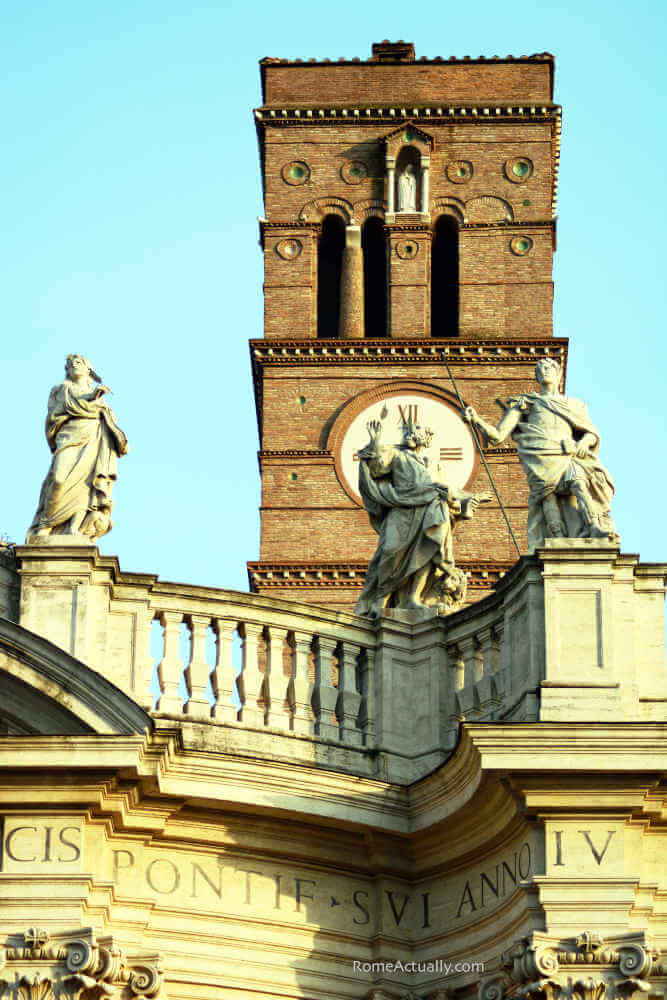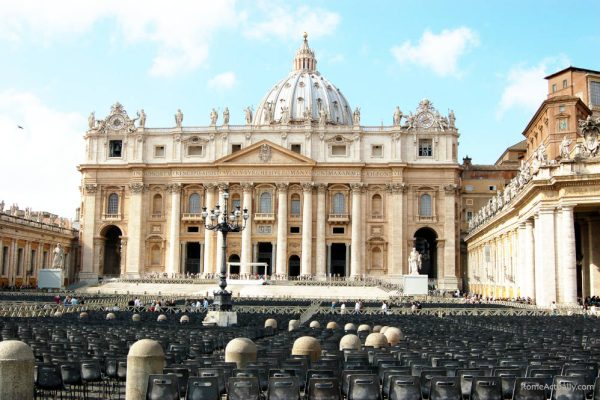Part of the ancient pilgrimage route of the Seven Churches started by San Filippo Neri, the Basilica of Santa Croce in Gerusalemme, also known as Basilica of the Holy Cross, very much cherished by the Knights Templar, is located in the Esquilino neighborhood between San Giovanni in Laterano Basilica and Porta Maggiore. Despite its impressive architecture, it is still one of the lesser-visited churches in Rome.
Almost leaning on the legendary Aurelian Walls, the basilica’s name means right what it says, that it has been keeping a reliquary of pieces from the Holy Cross found in Jerusalem’s Golgotha since the 4th century. It is believed that it was Helena herself who found the sacred relics of Christ’s passion and later brought them to Rome.
While it might not be the first landmark you are going to visit if you are staying in Rome for only one day, if you stay longer, it’s definitely worth a stop, even if only for half an hour.
History of Santa Croce in Gerusalemme Basilica
In my perpetual quest for hidden gems in Rome, I ended up in this church that holds a high artistic and historical value for the Italian and Catholic traditions.
Santa Croce in Gerusalemme Basilica underwent repeated renovation endeavors, and from an early-Christian church, it was remodeled into a Romanesque-style building in the 12th century during the reign of Pope Lucius II.
It finally obtain the late-Baroque look it has today as the result of the work of architects Pietro Passalacqua and Domenico Gregorini, commissioned by Pope Benedict XIV in the 18th century.
Its origins, however, are much more ancient and date back to the 3rd and 4th centuries, when the Esquilino was a suburban area.
At the beginning of the 4th century, the complex was chosen by Elena, the mother of Emperor Constantine, as her home. She then transformed the large atrium into a chapel to house the relics of the Holy Cross she had brought herself to Rome from Jerusalem. Around her chapel, it was built the Basilica which is also called “Eleniana” or “Sessoriana”.
On the site where now is the Santa Croce in Gerusalemme Basilica used to be an imperial complex known as “Horti Variani ad Spem Veterem” started by the emperor Septimius Severus. This included the Sessorium palace, the thermal baths of Helena, the mother of the emperor Constantine, the Variano Circus, and the Castrense Amphitheater.
It was inside the palace that the first church was built around 320 BCE and throughout the centuries several religious orders took over running the complex, including the Benedictine monks and the Cistercians.
What to see in Rome’s Basilica of the Holy Cross
Even though the most important and famous relics preserved here are pieces of the cross, there are also other sacred objects kept in this reliquary, including the Titulus Crucis, namely the inscription on the cross, a nail, two thorns believed to have belonged to the crown put on Jesus’ head, Saint Thomas’ finger, and a piece of the cross of the Penitent Thief.

If the interior looks simple when compared to other churches, especially those built in the Baroque style, Santa Croce in Gerusalemme Basilica enshrines some beautiful artwork. One of the first things to notice when you enter is the inlay stonework Cosmatesque floor, the original Roman pillars, and more sacred relics, those of San Cesario and Sant’Anastasio.
On the apsis, you will find a fresco by artist Antoniazzo Romano depicting a blessing Jesus surrounded by angels, and on top of a sequence of stories set in Jerusalem, fragments of the cross were found.
Worth seeing are also the chapels, Saint Helena’s, decorated with a rich mosaic, and Saint Gregory’s displaying a 17th-century sculpture. According to tradition, under the pavement of Saint Helena’s chapel was kept the dirt brought from Jerusalem.

Next to the Chapel of the Relics contains a copy of the Holy Shroud, a gift from the Diocesan Commission of the Shroud of Turin, and the Shroud Crucifix made by Monsignor Giulio Ricci.
At the foot of the Chapel, since 1999, have been kept the mortal remains of Antonietta Meo, known as “Nennolina”, a little girl who lived a few hundred meters from the Basilica in the 1930s and died at the age of six and a half years following osteosarcoma. In 2007, the Catholic Church declared her venerable.
What are the relics of the Holy Cross Basilica?
The Holy Relics kept in Santa Croce in Gerusalemme Basilica in Rome are small pieces from the Passion of Christ that have been preserved in gold-coated reliquaries. They are protected by a glass case and displayed for the many pilgrims and visitors that come to the Basilica.
Some of the relics have been brought by Saint Helen herself. These are the relics you can see:
- The Fragments of the True Cross (brought by Saint Elena)
- One of the nails used in the Crucifixion (brought by Saint Elena)
- Fragments of the Grotto of the Nativity and the Holy Sepulchre
- A part of the cross of the Good Thief
- Two thorns from the crown worn by Jesus during the Passion
- The sponge soaked in vinegar used to quench Jesus’ thirst
- The joint of the finger of St. Thomas
- One of Judas’ 30 denarii
- Titulus Crucis. This is the wooden table believed to have been placed on top of Jesus’ cross with part of Pontius Pilate’s inscription, “Jesus of Nazareth King of the Jews” written in Hebrew, Greek, and Latin characters. This was probably brought to the Basilica in the 6th century but historians are not 100% sure about its authenticity.
Practical information
- Address: Piazza di Santa Croce in Gerusalemme.
- How to reach: Metro (line C, Lodi stop), bus (16, 81, 3NAV), tram (3, 8).
- Opening hours: Monday-Saturday 7 am-12.45 pm and 3.30-7.30 pm. Sunday and holidays open at 7.30 am. During services, tours and visits are not allowed.
- Service hours: Monday to Saturday at 8 am and 7 pm, Sunday at 8 am, 10 am, 11,30 am, 7 pm
What to see around Santa Croce in Gerusalemme Basilica
- San Giovanni in Laterano Basilica. The most important Catholic basilica, the first of the four papal basilicas, and the oldest in the West. Known as Rome’s Cathedral, this is the main church of the city’s diocese.
- Porta Maggiore. This was the most important among Rome’s ancient gates. Here, you can see the ruins of four Roman aqueducts.
- Museo della Liberazione. The Museum of the Liberation of Rome shows documents and objects that chronicle the liberation of Rome after WWII.
- Ancient ruins. All around the Basilica, you will find several archaeological sites including the Amphitheatrum Castrense, Variano Circus in the Aurelian Walls, the archaeological area of Santa Croce in Gerusalemme, and parts of the Aurelian Walls themselves.
Where to eat near Santa Croce in Gerusalemme Basilica
- Al Grottino. This is a great pizza place very close to the Basilica but opens only for dinner. Closed on Tuesday (Via Orvieto 6).
- Osteria La Sol Fa. Unpretentious osteria serving traditional Roman dishes including pasta classics and meat dishes (Via Germano Sommeiller 19).
- Materia Cafe. Cozy bistro serving casual meals, homemade pasta, sandwiches, and coffee drinks (Via Andrea Provana 7).








